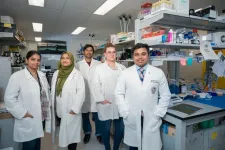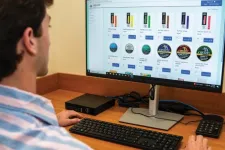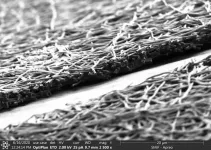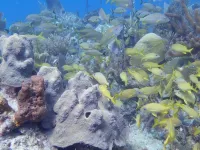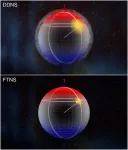(Press-News.org) As infrastructure ages, it becomes more susceptible to failure, which can cause safety and mobility concerns for drivers and pedestrians, and economic woes for taxpayers. A recent study published in “Transportation Research Record” shows that high-resolution synthetic aperture radar (SAR) satellite data can detect infrastructure issues early on, which can help prevent further damage to roads in the same way that annual checkups can help prevent more complex health issues in humans.
Led by Dr. Anand Puppala and Ph.D. candidate Amit Gajurel, researchers at Texas A&M University are working on a new method of infrastructure monitoring using Synthetic Aperture Radar (SAR) remote sensing systems. SAR allows researchers to inspect and characterize pavements, retaining walls, and embankments from space and can help determine if there are flaws that should be further inspected for repair, saving valuable time.
“If a given area would typically take five days to complete — between surveying the data and determining large and small areas of failure — when using the satellites, we could actually look at the data and make the same determinations in only two days, which can be very useful for time-saving,” said Puppala, A.P. & Florence Wiley Chair Professor in the Zachry Department of Civil and Environmental Engineering Department.
In addition to saving agencies time on repairs and preventative measures, utilizing satellites to monitor infrastructure and pavement conditions has the potential to reduce costs associated with managing roadway infrastructure assets.
“We’re building this up to use as a source of data for geotechnical asset management and looking at how to integrate this remote sensing data into geotechnical asset management,” said Gajurel. “We can use SAR data for managing the geotechnical assets. This could be a great method for organizations that are looking for a cost-effective way to manage these assets.”
SAR remote sensing technology has been used to study geomorphological changes and sudden movements like earthquakes and landslides.
“When there is damage due to a natural disaster, authorities use the satellite systems to determine what caused it. Recently we started utilizing this method to look at transportation infrastructure, including highway embankments, roads, and even airport runways,” said Puppala, who also serves as the director of the Center for Infrastructure Renewal at Texas A&M University.
As most doctors and patients would agree, preventative medicine is a better option than responding to an emergency. Preventative care provides doctors with more time to create the best plan for their patients. Likewise, by incorporating infrastructure condition data from SAR technology, asset managers can be proactive in repairing any flaws, budgeting for potential issues which can save both time and money that may be otherwise lost.
By Alyssa Schaechinger, Texas A&M University Engineering
END
Diagnosing damaged infrastructure from space
Texas A&M researchers have harnessed the power of satellites to constantly monitor infrastructure conditions and maintain them.
2024-06-06
ELSE PRESS RELEASES FROM THIS DATE:
Plenary speakers and key deadlines announced for ISSCR 2025 annual meeting in Hong Kong
2024-06-06
The International Society for Stem Cell Research (ISSCR) convenes world-renown scientists dedicated to stem cell research and regenerative medicine each year at its annual meeting to share the year’s most compelling basic discoveries and clinical breakthroughs in the stem cell field. Abstract submission and registration for ISSCR 2025, taking place 11-14 June 2025, will open on 2 October 2024. Abstracts submitted by 21 January 2025 will be considered for oral presentations and merit and travels awards.
The ISSCR is proud to announce the ...
UTEP pharmacy researchers develop potential treatment for fibrosis
2024-06-06
EL PASO, Texas (June 6, 2024) — Researchers at The University of Texas at El Paso are developing a new therapeutic approach that uses nanoparticles for the treatment of skin and lung fibrosis, conditions that can result in severe damage to the body’s tissues.
Md Nurunnabi, Ph.D., is an associate professor in UTEP’s School of Pharmacy and the lead researcher on two studies published this June in the medical Journal of Controlled Release; one study focuses on skin fibrosis and the other on lung fibrosis.
“We are closer than ever ...
Employers coast to coast join movement to turn bystanders into lifesavers
2024-06-06
DALLAS, June 5, 2024 — Nine out of 10 people who suffer cardiac arrest outside of the hospital die, and cardiopulmonary resuscitation (CPR), especially if performed immediately, can double or triple survival rates.[1] That is why the American Heart Association, celebrating 100 years of lifesaving service, will broaden efforts to drive CPR education at the community level through the Heart Walk® campaign. Heart Walk is the Association’s largest community-based activation engaging more than 220 cities ...
Flavor restrictions affect tobacco buyers differently depending on socioeconomic status, researchers say
2024-06-06
Restricting menthol flavor in cigarettes while making nicotine replacement therapy, such as a skin patch that can help ease withdrawal, more available and affordable has the potential to reduce socioeconomic disparities in tobacco use.
That was one of the findings in a study published in May in Nicotine and Tobacco Research that marks a new use of existing data from the Fralin Biomedical Research Institute at VTC’s Addiction Recovery Research Center. Researchers analyzed data from their Experimental Tobacco ...
Botanists and archaeologists receive National Science Foundation grant to study Mediterranean history
2024-06-06
It’s an unusual collaboration. Botanists and archaeologists don’t often work together, unless they’re studying the way people have used plants through time. But a new four-year grant from the National Science Foundation is shaking things up. It provides more than $1 million to study how Mediterranean plants that people have largely ignored evolved and diversified in one of the most formative periods of human history.
“The Mediterranean is at the crossroads of Europe,” said Nicolas Gauthier, curator ...
Silkworms help grow better organ-like tissues in labs
2024-06-06
DURHAM, N.C. -- Biomedical engineers at Duke University have developed a silk-based, ultrathin membrane that can be used in organ-on-a-chip models to better mimic the natural environment of cells and tissues within the body. When used in a kidney organ-on-a-chip platform, the membrane helped tissues grow to recreate the functionality of both healthy and diseased kidneys.
By allowing the cells to grow closer together, this new membrane helps researchers to better control the growth and function of the key cells and tissues of any organ, enabling them to more accurately model a wide range of diseases and test therapeutics.
The research appears June 4 in the journal Science Advances.
Often ...
Scientists ‘read’ the messages in chemical clues left by coral reef inhabitants
2024-06-06
What species live in this coral reef, and are they healthy? Chemical clues emitted by marine organisms might hold that information. But in underwater environments, invisible compounds create a complex “soup” that is hard for scientists to decipher. Now, researchers in ACS’ Journal of Proteome Research have demonstrated a way to extract and identify these indicator compounds in seawater. They found metabolites previously undetected on reefs, including three that may represent different reef organisms.
Plants and animals living in coral reefs release various substances, from complex macromolecules to individual amino acids, into the surrounding water. To determine ...
Identifying risk factors for native coronary atherosclerosis progression after percutaneous coronary intervention
2024-06-06
https://www.scienceopen.com/hosted-document?doi=10.15212/CVIA.2024.0033
Announcing a new article publication for Cardiovascular Innovations and Applications journal. This study was aimed at investigating factors influencing the progression of native coronary atherosclerosis after percutaneous coronary intervention (PCI).
A cohort of 462 patients was classified into progressive (n = 73) or non-progressive (n = 389) groups according to the presence of native coronary atherosclerosis progression on coronary angiography. ...
Mapping noise to improve quantum measurements
2024-06-06
One of the biggest challenges in quantum technology and quantum sensing is “noise”–seemingly random environmental disturbances that can disrupt the delicate quantum states of qubits, the fundamental units of quantum information. Looking deeper at this issue, JILA Associate Fellow and University of Colorado Boulder Physics Assistant Professor Shuo Sun recently collaborated with Andrés Montoya-Castillo, Assistant Professor of Chemistry, and his team to develop a new method for better understanding and controlling this noise, potentially paving the way for significant advancements in quantum computing, ...
Tiny predator owes its shape-shifting ability to “origami-like” cellular architecture
2024-06-06
For a tiny hunter of the microbial world that relies on extending its neck up to 30 times its body length to release its deadly attack, intricate origami-like cellular geometry is key. This geometry enables the rapid hyperextensibility of the neck-like protrusion, for single-celled predator Lacrymaria olor, a new study reports. The findings not only explain L. olor’s extreme shape-shifting ability but also hold potential for inspiring innovations in soft-matter engineering or the design of robotic systems. Single-celled protists are well known for their ability to perform dynamic morphological changes in ...
LAST 30 PRESS RELEASES:
Automatic label checking: The missing step in making reliable medical AI
Low daily alcohol intake linked to 50% heightened mouth cancer risk in India
American Meteorological Society announces Rick Spinrad as 2026 President-Elect
Biomass-based carbon capture spotlighted in newly released global climate webinar recording
Illuminating invisible nano pollutants: advanced bioimaging tracks the full journey of emerging nanoscale contaminants in living systems
How does age affect recovery from spinal cord injury?
Novel AI tool offers prognosis for patients with head and neck cancer
Fathers’ microplastic exposure tied to their children’s metabolic problems
Research validates laboratory model for studying high-grade serous ovarian cancer
SIR 2026 delivers transformative breakthroughs in minimally invasive medicine to improve patient care
Stem Cell Reports most downloaded papers of 2025 highlight the breadth and impact of stem cell research
Oxford-led study estimates NHS spends around 3% of its primary and secondary care budget on the health impacts of heat and cold in England
A researcher’s long quest leads to a smart composite breakthrough
Urban wild bees act as “microbial sensors” of city health.
New study finds where you live affects recovery after a hip fracture
Forecasting the impact of fully automated vehicle adoption on US road traffic injuries
Alcohol-related hospitalizations from 2016 to 2022
Semaglutide and hospitalizations in patients with obesity and established cardiovascular disease
Researchers ‘listen in’ to embryo-mother interactions during implantation using a culture system replicating the womb lining
How changing your diet could help save the world
How to make AI truly scalable and reliable for real-time traffic assignment?
Beyond fragmented markets: A new framework for efficient and stable ride-pooling
Can shape priors make road perception more reliable for autonomous driving?
AI tracks nearly 100 years of aging research, revealing key trends and gaps
Innovative techniques enable Italy’s first imaging of individual trapped atoms
KIER successfully develops Korea-made “calibration thermoelectric module” for measuring thermoelectric device performance
Diversifying US Midwest farming for stability and resilience
Emphasizing immigrants’ deservingness shifts attitudes
Japanese eels, climate change, and river temperature
Pusan National University researchers discover faster, smarter heat treatment for lightweight magnesium metals
[Press-News.org] Diagnosing damaged infrastructure from spaceTexas A&M researchers have harnessed the power of satellites to constantly monitor infrastructure conditions and maintain them.


